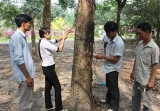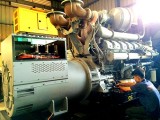Rational removal of obstacles to fulfill exportation strategy
According to the Department of Industry and Trade, export turnover in the first 10 months of 2017 is estimated at over US$ 23 billion, increasing by 17.4% over the same period by over US$ 5 billion. The structure of export commodities has shifted in line with the trend of increased processing industry proportion in line with the target of Export-Import Strategy of 2011-2020, with orientation to 2030 in Binh Duong.

In 10 months of 2017, wood industry’s exportation in Binh Duong Province exceeded outcome of 2016 by US$ 4.3 billion. In this photo: Wood processing is on-going at an enterprise in the province. Photo: Q. Chien
Strong growth of key exportation commodities
From the beginning of the year, the province's key products such as textiles, footwear, wood products, machinery, and spare parts are maintained at high export growth. Specifically, in 10 months, exportation of woodwork sector reached US$ 4.3 billion, which was US$ 3.5 billion in 2016. Similarly, textiles reached US$ 3.4 billion, which was US$ 2.9 billion in 2016 and footwear and leather shoes US$ 2.69 billion, which was US$ 2.1 billion in 2016. Tran Thanh Trong, Chairman of Binh Duong Electric Mechanical Association, General Director of Sang Ban Mai Joint Stock Company in Ben Cat Town informed that the growth rate of the company in the past 10 months reached 10% over the same period. The good news was that some members of the Binh Duong Association of Electrical and Mechanical Engineers had seen a 20% growth rate over the same period last year.
In order to facilitate business development, in the past years, Binh Duong has always paid attention to investment into infrastructure of industrial zones, transportation networks and logistics services. For supporting industry, the province has planned, built and developed in the direction of sustainable development and environmental protection in order to help enterprises take the initiative in obtaining raw materials, raising added value of goods and exportation. In addition, provincial leaders and departments have made efforts to effectively implement programs, projects, plans and solutions to create favorable conditions for the business community to access, open, and expand their export market, helping them feel secure for investment in production.
It can be said that the establishment of an auxiliary industrial zone of 300 hectares in Bau Bang district is bringing many advantages for businesses. In addition, the establishment of the Association of logistics service enterprises in Binh Duong is expected to strongly promote the logistics industry development.
To remove obstacles at the soonest
Investigation showed that the proportion of processed exports of provincial enterprises has improved, but some items such as wood, textiles, footwear, latex, and agricultural products have been of processing only. As a result, it is difficult to build a private brand for export products, making the added value very low. In addition, key export sectors such as wood products, textiles and footwear are heavily dependent on imported materials (accounting for 50-65% of production process) due to inadequate supply or material quality and price fail to meet the requirements of the manufacturer. As a result, export commodities are vulnerable to fluctuations in export prices and the scarcity of raw materials in the world market.
According to an unnamed representative of Binh Duong Textile Association, labor costs, warehousing, and transportation in the country are increasing, pressing on domestic garment enterprises. Enterprises are worried that til the end of the year they might face many difficulties due to fewer orders and short delivery time. In particular, the textile and garment industry in the country is under great pressure on the price of textile industry in some countries such as Bangladesh, Myanmar, and Cambodia which are growing strongly thanks to the 0% preferential tax incentive from the United States and the European Union. Huynh Quang Thanh, Chairman of Binh Duong Wood Processing Association, General Director of Hiep Long Co., Ltd. said that in the past 10 months, although the growth of the wood industry in Binh Duong reached over 10%, the price of raw materials is increasing. Meanwhile, most orders have been signed by businesses since late 2016.
Leaders of other enterprises said that the use of technical barriers and trade remedies of importing countries such as anti-dumping, self-defense and anti-subsidy tax are increasingly popular, especially in the context of tariffs being abolished under the commitments of the free trade agreements of countries. Meanwhile, the goods being sued are more and more diversified than they have been and are directly affecting the competitiveness of export goods of Binh Duong.
It is worth mentioning that the coordination of lawsuits and appeals of state agencies with business associations and enterprises have not been effective. Some businesses have not paid due attention to their duties and responsibilities in coordinating with the authorities to deal with trade remedies. Trade associations have not yet shown their role in taking the initiative to use trade remedies for imported goods in order to protect domestic goods. In addition, the supporting industry has been developed, but the policy is lacking, so it is not attractive enough for businesses to invest in development.
Reported by Tieu My – Translated by Vi Bao
- Socio-economic indicators increased over the same period (26/04)
- Connected traffic and upgraded urban areas (26/04)
- Impressions on the development journey (25/04)
- Ben Cat Town awards certificates of 12 typical rural industrial products in 2024 (25/04)
- Binh Duong Customs Department holds dialogue meeting with Korean businesses (25/04)
- Businesses concerned about rising exchange rate pressure (24/04)
- Q1-2024, provincial socio-economic situation continues to have positive changes (24/04)
- Policy credit requires local entrusted capital source to balance (23/04)
 Connected traffic and upgraded urban areas
Connected traffic and upgraded urban areas
 Binh Duong Customs Department holds dialogue meeting with Korean businesses
Binh Duong Customs Department holds dialogue meeting with Korean businesses
 Impressions on the development journey
Impressions on the development journey
 Businesses concerned about rising exchange rate pressure
Businesses concerned about rising exchange rate pressure
 Policy credit requires local entrusted capital source to balance
Policy credit requires local entrusted capital source to balance
 Thuan An city in striving to fulfill type-1 urban criteria
Thuan An city in striving to fulfill type-1 urban criteria
 Local real estate market strongly attracts foreign investors
Local real estate market strongly attracts foreign investors
 Firm steps of reforms
Firm steps of reforms
 Provincial enterprises are ready to join the global supply chain
Provincial enterprises are ready to join the global supply chain
 Infrastructure planning to develop modern ecosystem of modern logistics
Infrastructure planning to develop modern ecosystem of modern logistics





